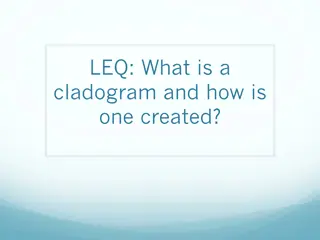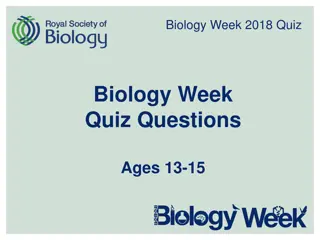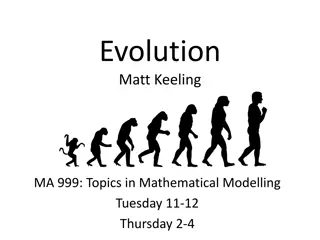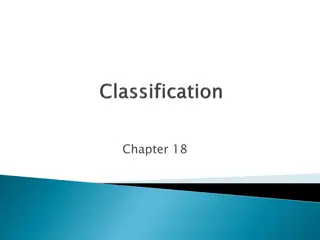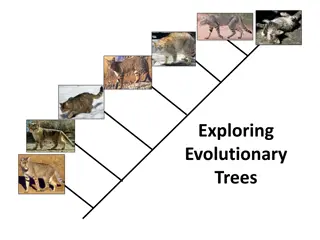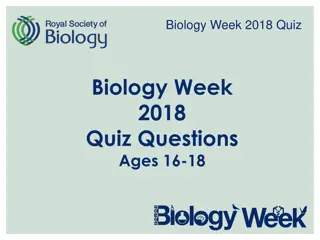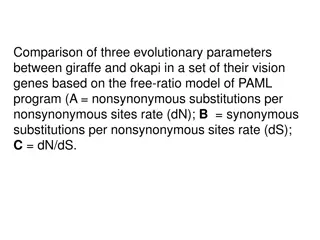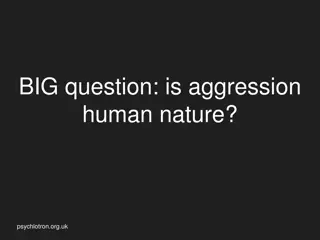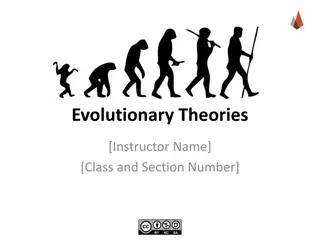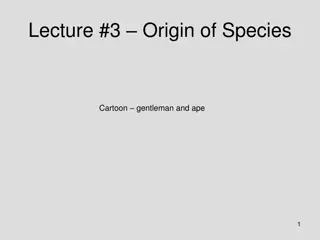Biology Quiz and Evolutionary History
Explore a interactive biology quiz covering topics like energy consumption in organisms, characteristics of cells and viruses, emergent properties, and the evolutionary history of life forms. Delve into the emergence of life forms during different time periods and uncover fascinating facts about the evolution of life on Earth. Test your knowledge and learn more about the wonders of biology and evolution.
Download Presentation

Please find below an Image/Link to download the presentation.
The content on the website is provided AS IS for your information and personal use only. It may not be sold, licensed, or shared on other websites without obtaining consent from the author.If you encounter any issues during the download, it is possible that the publisher has removed the file from their server.
You are allowed to download the files provided on this website for personal or commercial use, subject to the condition that they are used lawfully. All files are the property of their respective owners.
The content on the website is provided AS IS for your information and personal use only. It may not be sold, licensed, or shared on other websites without obtaining consent from the author.
E N D
Presentation Transcript
1. (4) In organisms, which of the following generally consumes the greatest amount of energy? a) Growth and development b) Homeostasis c) Reproduction 2. (2.5) Which of the following are true? (choose all that apply) a) Earth has a molten interior that recycles elements. b) Earth is in the right zone to allow liquid water. c) Earth is in the center of the galaxy, where there is a lot of energy. d) There is no life at the bottom of the ocean. e) Earth has an ozone layer that blocks UV light.
3. (3) Give an example of an emergent property and the level of the biological hierarchy in which it appears. 4. (3) Which of the following are true of cells, but not of viruses? (choose all that apply) a) They maintain homeostasis. b) They respond to stimuli. c) They grow and develop. d) They reproduce. e) They acquire and transform energy. f) They undergo evolution and natural selection.
(@)1.25) Match each of the following time periods with the emergence of the appropriate life form (use each letter only once): 1) Precambrian a. first birds and mammals 2) Vendian b. first fishes, amphibians, and reptiles 3) Paleozoic c. first humans 4) Mesozoic d. first animals or animal-like life 5) Cenozoic e. first prokaryotic and eukaryotic life. But wait, there s more
6. (@1.25): Which of the following statements is/are true? a. Life probably evolved within 1 billion years after the formation of the Earth. b. After it evolved, life on Earth was unicellular and prokaryotic for at least the first 2 billion years. c. Conditions on Earth in the tens of millions of years before the evolution of animals oscillated between freezing cold and boiling hot. d. Based on the fossil record, all modern animal phyla had evolved by 1 billion years ago, and appeared gradually over hundreds of millions of years. e. What we call birds evolved before what we call mammals . Bonus (2): The mass extinction at the end of the Period of the Era was the worst ever.
1. (3) Evolution is a _____ of biology. 2. (3) Natural selection is a _____ about evolution. 3. (2) Most evolutionary changes are the result of _____. 4. (2) Fitness refers to an organism s ability to _____ and reproduce. 5. (2) Natural selection can operate only on an organism s _____type. 6. (2) Genetic drift, sexual selection and natural selection all act to _____ genetic diversity. 7. (2) Random _____ mutations produce new alleles which can then be inherited. 8. (4) _____evolution refers to changes in the allelic frequencies within a population over time. _____evolution refers to changes above the population level and above over time.
1. (1.5) Evolution is a law of biology. 2. (1.5) Natural selection is a theory about evolution. 3. (1.5) Most evolutionary changes are the result of natural selection. 4. (1.5) Fitness refers to an organism s ability to survive and reproduce. 5. (1.5) Natural selection can operate only on an organism s phenotype. 6. (1.5) Genetic drift, sexual selection and natural selection all act to decrease genetic diversity. 7. (1.5) Random genetic mutations produce new alleles which can then be inherited. 8. (2) Microevolution refers to changes in the allelic frequencies within a population over time. Macroevolution refers to changes above the population level over time.
Answer the following (T/F): 1. Coevolution involves reciprocal natural selection. 2. Reciprocal natural selection produces and alters coevolutionary relationships. 3. The most common coevolutionary relationships are parasite-host (parasitism) and mutualisms. 4. A common coevolutionary sequence is parasitism > commensalism > mutualism. 5. Humans have endosymbiotes.
species together A a. b.+ c. + d.+ species separated A + Type of Interaction 1. Mutualism 2. Competition 3. Predation 4. Commensalism 5. A likely sequence for the development of a coevolutionary relationship between species is: a. mutualism > parasitism > commensalism b. commensalism > parasitism > mutualism c. commensalism > mutualism > parasitism d. parasitism > commensalism > mutualism e. parasitism > mutualism > commensalism B 0 + B + + 0
species together A a. b.+ c. + d.+ species separated A + Type of Interaction 1. Mutualism 2. Competition 3. Predation 4. Commensalism 5. A likely sequence for the development of a coevolutionary relationship between species is: a. mutualism > parasitism > commensalism b. commensalism > parasitism > mutualism c. commensalism > mutualism > parasitism d. parasitism > commensalism > mutualism e. parasitism > mutualism > commensalism B 0 + B + + 0
Match the following: 1. Sexual selection a. members of one sex choose mates of the other sex b. sex-specific physical characteristics c. organisms compete for mates with members of same sex d. choice of mates based on physical characteristics e. explainable by relative parental energy investment 2. Size dimorphism 3. Intersexual selection the 4. Intrasexual selection 5. Sexual dimorphism
Match the following: 1. Sexual selection d a. members of one sex choose mates of the other sex b. sex-specific physical characteristics 2. Size dimorphism e 3. Intersexual selection a c. organisms compete for mates with members of same sex the 4. Intrasexual selection c d. choice of mates based on physical characteristics 5. Sexual dimorphism b e. explainable by relative parental energy investment







